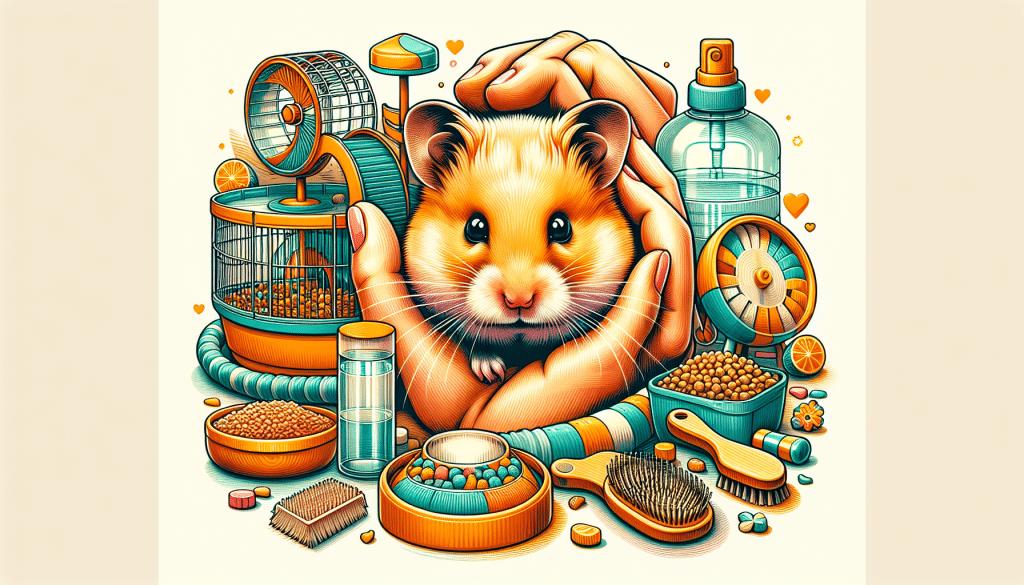So you’ve decided to bring a furry little friend into your home and have set your sights on a hamster. These small, adorable creatures make great pets, but caring for them requires some knowledge and attention. In this ultimate guide, we will explore everything you need to know about taking care of hamsters, from choosing the right cage and bedding to providing the proper diet and exercise, ensuring your furry companion lives a happy and healthy life by your side. Whether you’re a first-time hamster owner or looking to brush up on your hamster care skills, this guide has got you covered. So let’s jump right in and become hamster experts!
Understanding the Basics of Hamster Care

Different types of hamsters
When it comes to hamsters, there are various types that you can choose from. Some of the most popular ones include Syrian hamsters, Dwarf hamsters, Roborovski hamsters, and Chinese hamsters. Each type has its own unique characteristics and needs, so it’s important to do your research and choose the one that best fits your lifestyle and preferences.
Life expectancy of hamsters
Hamsters generally have a relatively short lifespan compared to other pets. On average, they can live anywhere between 1.5 to 3 years, depending on the type of hamster and their overall health. This means that they require your attention and care during their relatively short lives.
Characteristics of hamsters
Hamsters have a number of interesting characteristics that make them great pets. They are nocturnal, which means they are most active during the night and tend to sleep during the day. Hamsters are also known for their burrowing and hoarding behaviors, as they like to create tunnels and store food in their cages. Understanding these natural behaviors will help you create a suitable living environment for your furry friend.
Creating a Suitable Living Environment

Choosing the right cage
One of the most important aspects of hamster care is providing them with a suitable cage. The cage should be spacious enough to allow the hamster to move around comfortably, with plenty of space for exercise. Wire cages with a solid base are a popular choice as they allow for good ventilation and prevent the hamster from escaping. Make sure to choose a cage with narrow bar spacing to prevent your hamster from getting stuck.
Proper cage location
The location of the hamster’s cage is also important for their well-being. Hamsters should be kept in a quiet area of your home, away from direct sunlight and drafts. Avoid placing the cage in areas with high humidity or temperature fluctuations, as these can be detrimental to your hamster’s health. Also, keep in mind that hamsters are sensitive to noise, so choose a spot where they can have some peace and quiet.
Essential cage accessories
To make your hamster’s living environment more stimulating and comfortable, you’ll need to provide them with essential cage accessories. These include a water bottle or dish for fresh water, a food bowl for their daily meals, a hiding house or tunnel for them to feel secure, and a bedding material like aspen shavings or paper-based bedding for them to burrow and nest in. Additionally, adding chew toys and an exercise wheel will help keep your hamster mentally stimulated and physically active.
Nutrition for Hamsters

Types of food for hamsters
Hamsters have specific dietary needs that must be met to ensure their overall health and well-being. A good quality hamster pellet or mix should serve as the main component of their diet. These specially formulated pellets or mixes contain a balanced blend of grains, seeds, vegetables, and proteins to provide your hamster with the necessary nutrients. It’s important to avoid feeding them sugary or fatty foods, as these can lead to obesity and other health issues.
The proper feeding schedule
Establishing a proper feeding schedule is essential for your hamster’s health. Hamsters are omnivores and should be fed once a day, preferably in the evening when they are most active. Give them a small portion of fresh fruits and vegetables along with a measured amount of pellets or mix. Keep an eye on their eating habits and adjust the amount of food accordingly. Remember to always provide fresh water in a water bottle or dish, and change it daily.
Treats and foods to avoid
While it may be tempting to spoil your hamster with treats, it’s important to be mindful of what you offer them. Some safe and healthy treat options include small pieces of fresh fruits and vegetables, cooked plain chicken or scrambled eggs. However, avoid giving them foods that are high in sugar, salt, or fat, as well as any toxic foods such as chocolate, caffeine, onions, or garlic. These can be harmful to your hamster and may cause digestive issues or even poisoning.
Hamster Hygiene

Cleaning the cage
Regular cage cleaning is essential to maintain a clean and healthy living environment for your hamster. Spot clean the cage daily, removing any soiled bedding or uneaten food. Once a week, empty the entire cage and give it a thorough clean with mild soap and water. Rinse the cage thoroughly and allow it to dry completely before adding fresh bedding and returning your hamster. By keeping the cage clean, you’ll help prevent the buildup of bacteria and odor.
Bathing hamsters
Contrary to popular belief, hamsters do not require regular baths like other pets. In fact, bathing a hamster can be stressful for them and may strip their fur of its natural oils. Hamsters are capable of grooming themselves, and they have a natural cleaning method using their tongues and paws. If your hamster’s fur becomes visibly dirty or matted, you can spot clean it using a damp cloth or tissue. However, it’s best to avoid unnecessary bathing unless recommended by a veterinarian.
Maintaining proper hamster grooming
While hamsters groom themselves, you can assist in their grooming routine by providing them with the necessary tools. Place a small container of chinchilla sand in their cage, as this will help them keep their fur clean and free from excess oils. Additionally, provide them with a chew toy or mineral block to help wear down their teeth, which grow continuously throughout their lives. Regular nail trims may also be necessary if your hamster’s nails become too long.
Hamster Health Care

Common health issues in hamsters
Like any other living creature, hamsters are susceptible to certain health issues. Some common health problems in hamsters include respiratory infections, dental diseases, obesity, and skin conditions. It’s important to keep an eye out for any signs of illness, such as changes in appetite, weight loss, lethargy, or abnormal behavior. If you notice any concerning symptoms, it’s best to consult a veterinarian who specializes in small animals.
Preventive care for hamsters
Preventive care plays a crucial role in keeping your hamster healthy and happy. This includes providing a balanced diet, regular exercise, and a clean living environment. Additionally, ensure that your hamster receives adequate mental stimulation and social interaction. Regularly check your hamster’s teeth, nails, and fur for any abnormalities, and maintain a consistent grooming routine. By being proactive in preventive care, you can help minimize the risk of health issues in your hamster.
When to consult a veterinarian
If you notice any significant changes in your hamster’s behavior, appearance, or overall well-being, it’s important to consult a veterinarian who specializes in small animals. They will be able to assess your hamster’s condition and provide appropriate treatment if necessary. It’s always better to seek professional help sooner rather than later, as certain health issues can worsen rapidly in hamsters.
Considering Hamster Psychology

Understanding hamster behavior
To provide the best care for your hamster, it’s important to understand their behavior. Hamsters are naturally solitary animals, so it’s common for them to display territorial behavior. They also love to burrow, hoard food, and are generally active during the night. Observing and understanding these behaviors will help you create a suitable environment and interact with your hamster in a way that respects their natural instincts.
The effects of stress on hamsters
Hamsters are sensitive creatures and can easily become stressed by certain factors. Loud noises, excessive handling, sudden environmental changes, or overcrowding can all cause stress in hamsters. Prolonged stress can lead to health issues and a decline in your hamster’s overall well-being. It’s important to provide a calm and quiet environment for your hamster, avoiding unnecessary stressors to ensure their mental and physical health.
Taming and handling hamsters
Taming and handling your hamster is an important part of their socialization process. Start by allowing your hamster to get used to your presence by placing your hand near their cage and letting them approach you on their own terms. Once they become comfortable, gently and slowly scoop them up, supporting their body with your hands. Avoid sudden movements or gripping them tightly. Regular handling will help build trust and strengthen the bond between you and your hamster.
Exercise and Play for Hamsters
Securing safe play areas
Hamsters are active animals and need plenty of opportunities for exercise and play. Before allowing your hamster to explore outside of their cage, it’s important to secure the play area to prevent any escapes or accidents. Make sure the area is free from any small openings or hazards, such as wires, toxic plants, or other pets. Set up a safe and enclosed space where your hamster can play and explore under your supervision.
Hamster wheel considerations
A hamster wheel is an essential accessory for your hamster’s physical exercise. It allows them to run and burn off excess energy. When choosing a hamster wheel, opt for one with a solid surface to prevent your hamster’s feet from getting trapped. Ensure that the wheel is appropriately sized for your hamster, as one that is too small can cause discomfort and injuries. Offer the wheel as a voluntary activity and never force your hamster to use it.
Toys and games for hamsters
Providing your hamster with a variety of toys and games is important for their mental stimulation and overall well-being. Some popular toys for hamsters include tunnels, chew toys, puzzle feeders, and gnawing blocks. These toys encourage natural behaviors, such as exploration, chewing, and foraging. Rotate the toys regularly to keep your hamster engaged and avoid boredom. DIY toys, made from safe materials, can also be a creative and cost-effective option.
Hamster Breeding
Signs of hamster pregnancy
If you have a male and female hamster living together, it’s important to be aware of the signs of pregnancy. A pregnant hamster will have a visibly swollen abdomen and may exhibit nesting behaviors, such as collecting bedding materials. As the pregnancy progresses, you may also notice the movement of the babies inside the mother’s belly. However, keep in mind that breeding hamsters should only be done by experienced breeders who have a thorough understanding of the process.
Caring for pregnant hamsters
If you believe your hamster is pregnant, it’s essential to provide her with the necessary care. Ensure that she has a quiet and secluded area in the cage where she can build a nest and give birth. Offer her extra nesting materials, such as shredded paper or tissue, to help her create a comfortable environment. Make sure to provide a well-balanced diet to support her and her developing babies’ nutritional needs.
Handling newborn hamsters
Hamster babies, also known as pups, are born hairless and blind. It’s important to avoid handling them for at least the first week to prevent stress or injury to the delicate newborns. Allow the mother to take care of their needs, ensuring she has a constant supply of food and water. Keep an eye out for any signs of weakness or illness in the pups, and consult a veterinarian if any concerns arise.
Providing Social and Mental Stimulation
Interacting with your hamster
Hamsters, although naturally solitary, still appreciate social interactions with their human caregivers. Spend time near their cage, talking softly to them and allowing them to get used to your presence. Once your hamster becomes comfortable, you can gently stroke them or offer treats from your hand. Remember to always approach your hamster calmly and avoid sudden movements, as this can startle or stress them.
Teaching hamster tricks
Teaching your hamster tricks can be both a fun and rewarding experience. Start with simple commands, such as “come” or “up,” and use positive reinforcement, such as treats or praise, to encourage their progress. Keep training sessions short and frequent, as hamsters have short attention spans. With patience and consistency, your hamster can learn to respond to commands and perform cool tricks.
Avoiding hamster boredom
Boredom can lead to stress and behavioral issues in hamsters, so it’s essential to provide them with enough mental and physical stimulation. Rotate their toys regularly to keep them engaged, and provide different types of play structures, such as tunnels or climbing platforms. Create a foraging experience by hiding treats or food in different areas of their cage to stimulate their natural instincts. Additionally, consider providing a safe and supervised “playpen” outside of their cage where they can explore new environments.
Planning for Hamster Travel
Traveling with a hamster: A guide
If you need to travel with your hamster, it’s important to plan ahead to ensure their safety and comfort. Always provide a secure travel cage or carrier that is well-ventilated and escape-proof. Keep the travel cage away from direct sunlight and drafts, and monitor the temperature to prevent overheating or chilling. Pack a sufficient amount of their usual food, fresh water, bedding, and familiar toys to provide a sense of comfort during the journey.
Hamster travel cages
Choosing the right travel cage is crucial for the well-being of your hamster during travel. Look for a cage that is specifically designed for transporting small animals, with secure latches and good ventilation. Avoid using cardboard boxes or other types of containers that may provide inadequate protection or airflow. Ensure that the travel cage is properly secured in the vehicle to prevent any sudden movements or accidents.
Ensuring your hamster’s comfort during travel
During the journey, it’s important to regularly check on your hamster to ensure their comfort and well-being. Avoid exposing them to extreme temperatures or loud noises, as these can cause stress and anxiety. If possible, cover the travel cage with a light cloth to provide a sense of security and reduce external stimuli. Ensure that the cage remains stable and secure throughout the journey to avoid unnecessary movements that may distress your hamster.
Taking care of a hamster requires dedication and proper knowledge of their specific needs. By understanding the basics of hamster care, creating a suitable living environment, providing proper nutrition, maintaining their hygiene, ensuring their health care, considering their psychology and providing mental stimulation, and planning for travel, you can give your furry friend the love and care they deserve. Remember to always observe your hamster’s behavior and consult a veterinarian if you have any concerns about their health or well-being. With proper care and attention, your hamster can live a happy and fulfilling life by your side.



